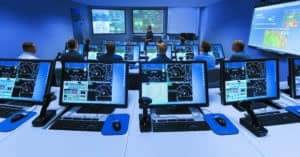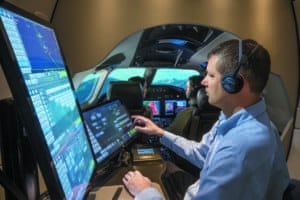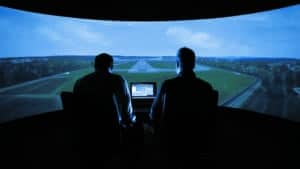FlightSafety
“The best safety device in any aircraft is a well-trained crew.”
This maxim was more than just words to A.L. Ueltschi: it was a way of life. Ueltschi founded FlightSafety International in 1951, in order to help build a culture of safety in the industry he loved.
When Ueltschi founded FlightSafety, business aviation was in its infancy. A handful of corporate pilots flew converted military aircraft for industry leaders and wealthy individuals. These pilots, unlike their commercial airline counterparts, did not have and were not required to undergo any formal training.
“All of us with FlightSafety are pleased and proud to serve Jet Linx,” said Bruce Whitman, Chairman, President and CEO. “We appreciate the trust they have placed in us, and are committed to continuously provide the highest quality training and outstanding services Jet Linx deserves and expects.”
 “Today, FlightSafety conducts over 1.4 million hours of training each year. It is delivered by our 1,800 instructors at more than 40 centers throughout the world,” said Steve Gross, Senior Vice President, Commercial. “We want to make sure that every pilot, maintenance technician, flight attendant, and dispatcher has the information and training needed to operate or support their aircraft safely and efficiently.” FlightSafety is the preferred training partner for Jet Linx Aviation: read on to learn more about their dedication to ensuring that every pilot has the best training possible.
“Today, FlightSafety conducts over 1.4 million hours of training each year. It is delivered by our 1,800 instructors at more than 40 centers throughout the world,” said Steve Gross, Senior Vice President, Commercial. “We want to make sure that every pilot, maintenance technician, flight attendant, and dispatcher has the information and training needed to operate or support their aircraft safely and efficiently.” FlightSafety is the preferred training partner for Jet Linx Aviation: read on to learn more about their dedication to ensuring that every pilot has the best training possible.
Ueltschi first soloed in 1933 at age 16 in an OX-5 Waco. The entrepreneur got his start in business with Little Hawk burger stands, but became a Pan American Airways pilot in 1941. After a decade with Pan Am, Ueltschi’s mission to provide training to the aviation industry was set and FlightSafety started operations at New York’s LaGuardia Airport. During FlightSafety’s early years, Ueltschi kept working at Pan Am while his company grew. FlightSafety began operations with a Link trainer, and purchased its first flight simulator in 1955. Since then, FlightSafety has grown to become the world leader in aviation training and a leading supplier of flight simulators to commercial airlines and government agencies around the world. FlightSafety serves the vast majority of business aircraft manufacturers as a factory authorized training provider, and works closely with them to create simulators that operate exactly as an aircraft would in a real-life scenario.
FlightSafety’s relationships with aircraft manufacturers are a benefit to Jet Linx. “FlightSafety is the leading training provider for pilots, maintenance technicians and other aviation professionals who operate aircraft built by Airbus Helicopters, Beechcraft, Bell Helicopter, Bombardier, Cessna, Dassault, Embraer, Gulfstream, Hawker, HondaJet, Leonardo Helicopters, Piaggio, Pilatus, and Sikorsky,” said Gross. “This has resulted in building relationships of trust and working closely together to provide the highest quality training,” Gross explained. “An excellent example is FlightSafety’s new series of advanced courses. They are designed to develop and enhance superior flying skills, swift, accurate, and correct decision making and precise and effective crew communication. The courses are based on analysis of actual aircraft accidents and incidents and focus on prevention and recovery.”
Advance Upset Prevention and Recovery focuses on preventing in-flight loss of control, and recovery from upset if prevention is not  possible. The aerodynamic model developed by FlightSafety and incorporated into the simulators replicates the flight envelope from full aerodynamic stall to speeds well beyond VMO/MMO. This allows pilots to experience and recover from full aerodynamic stall and high speed events in the safe and controlled environment of a simulator.
possible. The aerodynamic model developed by FlightSafety and incorporated into the simulators replicates the flight envelope from full aerodynamic stall to speeds well beyond VMO/MMO. This allows pilots to experience and recover from full aerodynamic stall and high speed events in the safe and controlled environment of a simulator.
CRM/Human Factors LOFT is designed to assess and enhance CRM performance and complex decision making during a long range international flight. It addresses competency in crew coordination, communication, monitoring skills, intervention protocols, resilience and response to unforeseen events.
Energy Management concentrates on the physics of managing an aircraft’s total energy during descent. It presents eight scenarios that enable pilots to understand and predict in advance whether or not they will meet stabilized approach criteria.
The Rejected Takeoff and Go/No-Go decision course helps pilots to make a nearly instantaneous decision on whether to abort or continue the takeoff during 18+ scenarios near V1.
“When you choose FlightSafety, you leverage the unmatched resources of the world leader in aviation training and simulation. We provide factory authorized training for the vast majority of business and regional aircraft manufacturers. Our training programs are tailored to meet the specific needs of our customers. The learning culture is embedded into everything we do at FlightSafety. The company has its own facility to manufacture simulators, but they’re mostly for use in its own training centers. Training begins before pilots enter the simulator: desktop programs recreate the atmosphere of the cockpit so it’s familiar. The pilots become immersed into the entire cockpit from day one: it’s a 21-day initial course. They’ll essentially start by desk-flying the airplane and learning the avionics and other systems,” said Gross.
 Beyond the advancements in simulator and classroom technology, FlightSafety offers specialized training because of some of the challenging – and most common – airports Jet Linx flies to. “I think we probably have more small airports in our database than other providers,” Gross explained. “They include Trenton, N.J.; Van Nuys, Calif.; Telluride, Colo.; and many others. Telluride is a high altitude airport with a dip in the middle of the runway, which can be challenging without experience because it’s one way in and one way out. That dip you can get you in trouble.”
Beyond the advancements in simulator and classroom technology, FlightSafety offers specialized training because of some of the challenging – and most common – airports Jet Linx flies to. “I think we probably have more small airports in our database than other providers,” Gross explained. “They include Trenton, N.J.; Van Nuys, Calif.; Telluride, Colo.; and many others. Telluride is a high altitude airport with a dip in the middle of the runway, which can be challenging without experience because it’s one way in and one way out. That dip you can get you in trouble.”
In order for the simulator training to be effective, it must be accurate to what pilots would experience in a real airplane. Technology advancements over the last half-century have allowed FlightSafety to go into great detail with the performance of the simulators. “We have done modeling on, say, if a wheel were to exit the side of the runway, to make sure that was dynamically set up the way the airplane would feel,” Gross said. “It sounds simple, but it’s actually fairly complex to be able to give the pilots that experience in order to make practicing the recovery techniques to get back on the runway realistic and accurate.”
FlightSafety’s training is led by top-of-the-line, dedicated training instructors. “There are many training providers that use a vast majority of their instructors as part-time instructors who also have other jobs and who are not entirely immersed and dedicated to the training environment,” said Mike Kopp, Jet Linx Aviation Director of Operations. “FlightSafety has a much greater number of full-time, dedicated instructors, ground instructors and simulator instructors.”
Kopp noted that one of the Beechjet instructors had been with FlightSafety for over 15 years. “He’s been there in the same program, so clearly he’s an expert in his field in the knowledge of that aircraft type,” he said.

“We have a great working relationship with FlightSafety and we chose them as our preferred training provider because while we have diversity in our fleet, FlightSafety has as much diversity and as much ability to train as any other training center or provider. They’ve got the most locations and the most options for different aircraft types to train.” – Mike Kopp, Jet Linx Director of Operations
Other materials used in training are held to FlightSafety’s highest standards. “I believe that their innovation, as well as their instructional delivery methods along with their course materials, publications, and things like that, are more professionally done and easier to use than many of the other training providers,” Kopp explained. Pre-course study materials are available in electronic formats, and the desktop programs pilots use before entering a simulator build a pilot’s knowledgebase, preparing them for success.
The teams at FlightSafety make sure that their training programs work, and aren’t afraid of making adjustments to make sure pilots are successful. Gross recalled a time when the training program for an airplane with newer avionics had a higher than normal failure rate with pilots new to the type. “We stopped and looked at the program and asked, ‘What’s going wrong here?'” he remembered. The class had been structured with aircraft systems the first week, then avionics, then simulator time. “We actually had to turn that whole program nose-to-tail, and we learned that we had to start the pilots on the avionics day one.” FlightSafety’s organizational knowledge of how a pilot or a maintenance technician learns the system of an airplane was able to improve training on that aircraft, and has informed the structure of courses for other airplanes.
Today, the training has less of a system-by-system approach, and uses flight profiles instead. “It’s like the beginning to end of a particular trip, where everything is incorporated: from the preflight planning and the preflight inspection of the airplane, to the line and the cockpit checks,” Kopp said. “Then there will be this electrical system issue, and this hydraulic system issue, and you train on the systems as if these things were occurring in a real-life scenario.” This allows the pilots to cover much more ground during one training session. “You might take a four-hour course and cover 80% of the systems of the airplane in an actual in-flight environment,” he continued.

“We’ve had such a long-lasting relationship with them that they understand what our training goals are, because we ask them to train above and beyond what is in the training program. For example, we ask for additional training for crewmembers in the simulator for specific airports such as Aspen and Eagle, where we have a tremendous amount of flights.” – Jes Wingad, Jet Linx Training Manager
The Jet Linx team works closely with FlightSafety to make sure pilots are able to complete training on time, and at a convenient time. Every Jet Linx pilot passes an initial training when hired, and then annual training after that, and Pilots In Command must also fulfill an instrument proficiency check every six months. In order to make sure that pilots are scheduled in a timely fashion, the teams stay in close contact. “We maintain constant communication with them,” Kopp said. “We have a phone call every single week with FlightSafety – with our Talent Acquisition team, with our training manager, with myself. We go through what’s been requested, where do we need slots available, and what do we need to move. They dedicate this time to us every single week to manage that schedule for us and to most effectively get our people trained.”
The training Jet Linx pilots receive at FlightSafety includes everything their regular training programs offer – and then some. “We ask FlightSafety to train our pilots to specific goals we have fleet-wide, so there’s standardization,” said Jes Wingad, Jet Linx Aviation Training Manager. “Any Beechjet pilot from Atlanta could go fly with a Beechjet pilot from Dallas: you’re going to have a pilot trained the same way.” In addition to standard operating procedures, this includes airport-specific training and additional simulator time. “FlightSafety tailors its training to the specific needs of Jet Linx. Jet Linx pilots complete intensive ground-school and rigorous training sessions in full flight simulators,” said Gross. “The advanced technology simulators and other advanced training devices replicate an aircraft’s performance characteristics. This allows crews to remain proficient and practice managing multiple-event emergencies that would be impossible to safely create in an actual aircraft.”
Jet Linx and FlightSafety are able to work so well together because both share a common goal: to ensure the safety of all passengers. “Jet Linx’s commitment to training with FlightSafety reflects the company’s dedication to safety,” said Whitman. This close working relationship ensures that Jet Linx crewmembers always receive a full complement of training that meets their specific needs. It also promotes the continual exchange of new ideas, stimulating creativity and communication between the two organizations and making certain that Jet Linx continues to have the world’s highest quality and most innovative pilot training programs.
Related Stories
Cheers to 20 Years
Six members of Team Jet Linx celebrate two decades of Five-Star service.
READ MORE
Immerse Yourself
More than 40 years after pioneering one of the first health and wellness resorts in Tucson, AZ, Jet Linx Elevated Lifestyle partner Canyon Ranch continues to redefine what wellness-focused getaways can offer.
READ MORE
What Kind of Caviar Are You?
Whether you are a caviar newbie or a seasoned connoisseur, Jet Linx Elevated Lifestyle partner Petrossian has a caviar for your tastes.
READ MORE
Related Stories
Cheers to 20 Years
Six members of Team Jet Linx celebrate two decades of Five-Star service.
READ MORE
Immerse Yourself
More than 40 years after pioneering one of the first health and wellness resorts in Tucson, AZ, Jet Linx Elevated Lifestyle partner Canyon Ranch continues to redefine what wellness-focused getaways can offer.
READ MORE
What Kind of Caviar Are You?
Whether you are a caviar newbie or a seasoned connoisseur, Jet Linx Elevated Lifestyle partner Petrossian has a caviar for your tastes.
READ MORE



Contact Us